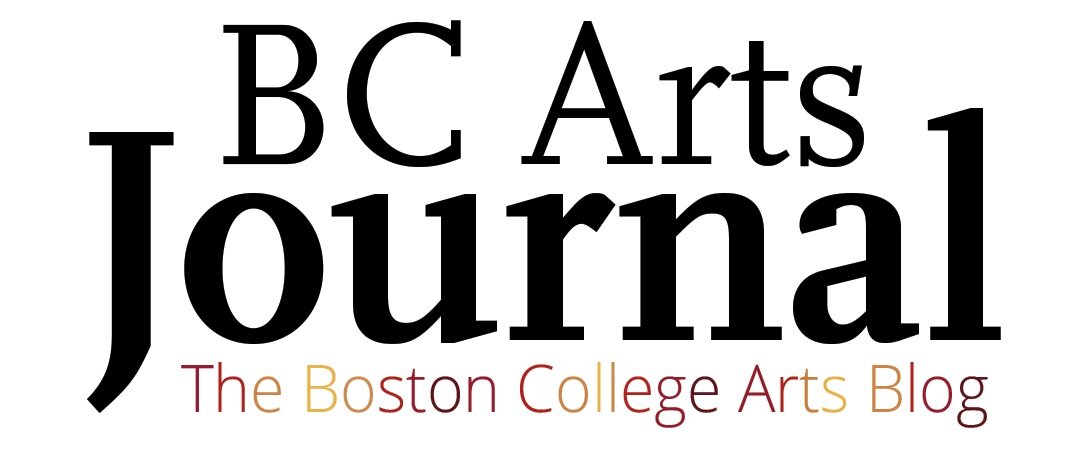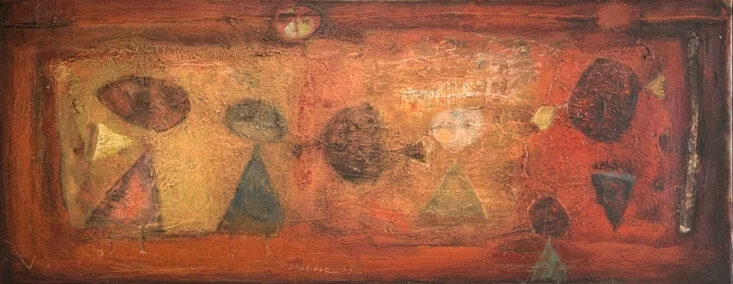Reviewing the McMullen’s “Taking Shape: Abstraction From the Arab World, 1950s— 1980s”
by Katy Gilmore ‘24
A few weeks ago, I had the opportunity to visit the exhibit, “Taking Shape: Abstraction From the Arab World, 1950s— 1980s” at the McMullen Museum of Art. Afterwards, I attended a virtual tour of the galleries led by manager Rachel Chamberlain with docents Karen Recco and Kate Hurley. Prior to visiting, I had never truly studied Arab art outside of a European lens. The careful curation and descriptions of the pieces opened up an entire world of art for me. I left both my in-person and virtual visits in awe of the range and complexity of the galleries.
The exhibit contains artwork from fourteen countries in North Africa and the Middle East from the collection of Sultan Al-Kasemi. It features a very diverse group of artists of different genders, origins, and cultural, economic, and religious backgrounds. All of the art in the exhibit follows the fall of the Ottoman empire and so touches on the impacts of colonialism, industrialization, the growth of oil trade, and political turmoil. To push against the monopoly the Western world has on art consumption, this exhibit shifts from a purely Eurocentric approach to art to a more global view centered in the Arab world.
Untitled
Munira Al-Kazi
Each gallery in the exhibit displays a different style or subject matter within the world of Arab art all connected through abstraction. Even though certain themes carry across the galleries, what I enjoyed the most about the exhibit was the uniqueness of each piece. Every artist had an individual story to tell that connected to a broader tale of the Arab experience.
The second gallery of the exhibit stood out to me for its incorporation of language with art. The paintings all subscribed to the lettrism or hurufiyya movement (the use of the Arabic alphabet in art). One example of this style from the exhibit is La Ana Illa Ana (There Is No “I” but “I”) by Kamal Boullata. The pieces of this gallery draw on the tradition of calligraphy, using Arabic letters both for their actual meaning and for their form. I absolutely recommend spending time in this gallery to admire the beauty of combining something so essential to the Arab world as their language with the art they produce.
The gallery centered around Sufi modern art also caught my attention. The pieces draw on key aspects of Sufi Islam such as mysticism and introspection. Untitled by Omar El-Nagdi is one of the works in the gallery that uses its form to emulate the Sufi message in addition to its content. The repeated brush strokes that make up the painting is a meditative exercise in itself, an essential practice to Sufi Islam.
To Monet
Abdallah Benanteur
Some of the paintings I was the most drawn to were To Monet, Giverny and The Garden of Saadi both by Abdallah Benanteur in the gallery focused on abstract expressionism. Their shapes and bright colors kept me standing in front of them longer than any other piece. I then learned in the virtual tour I attended that Benanteur was an early pioneer of Algerian modernism and worked in collaboration with poets and Sufi mystics— influences of both can be seen in the paintings of his in the exhibit. He was educated in France, and this painting draws on the French tradition of romantic impressionism. He alludes to famous French artists like Claude Monet while combining those references with images of Algeria and his style of abstraction. His pieces speak to a legacy of art while also incorporating his own history as an individual and an Algerian. The cross-cultural nature of his paintings and the beauty of his technique and color choice will have you contemplating his art long after leaving the McMullen.
When you attend this exhibit, make sure not to miss the final gallery on the third floor. This portion focuses on individuality, and altogether the pieces create a diverse narrative detailing different aspects of the Arab experience. Some of the pieces in this gallery struck me because they referenced other art mediums to convey the artists’ story. These include Dream Walkers by Hussein Shariffe which resembles a movie seen, and Untitled by Munira Al-Kazi which has a comic-like structure. This section also includes a notable female artist named Widjan who has been extremely involved in the progression of Arab art throughout the Middle East and North Africa.
Dream Walkers
Hussein Shariffe
“Taking Shape: Abstraction From the Arab World, 1950s— 1980s” will continue until June 4th. If you are able, I highly recommend visiting in person before it ends (you can schedule a time if you are a Boston College student or faculty member). Virtual docent tours are also offered every Friday at 3:00 pm, and last about 45 minutes. You can also do your own virtual walkthrough with interactive videos on the McMullen website.
Each of these pieces show differences in artistic style, regional backgrounds, and individual experiences, but abstractionism connects them all. Given the current state of the world, it is more important than ever right now to recognize both what differentiates and unites us. One channel of doing so is through art and story-telling. This exhibit encourages us to acknowledge our dissimilarities, but also calls upon us to trace themes across the human experience.



